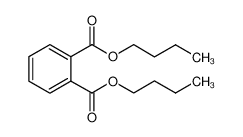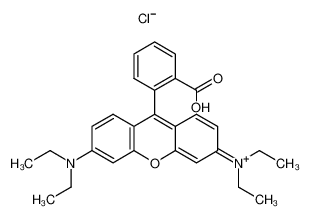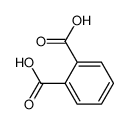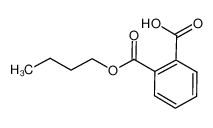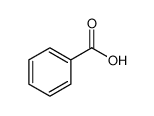1.Identification
1.1 GHS Product identifier
| Product name | dibutyl phthalate |
|---|
1.2 Other means of identification
| Product number | - |
|---|---|
| Other names | phthalic acid dibutyl ester |
1.3 Recommended use of the chemical and restrictions on use
| Identified uses | For industry use only. Phthalates |
|---|---|
| Uses advised against | no data available |
1.4 Supplier's details
| Company | MOLBASE (Shanghai) Biotechnology Co., Ltd. |
|---|---|
| Address | Floor 4 & 5, Building 12, No. 1001 North Qinzhou Road, Xuhui District, Shanghai, China |
| Telephone | +86(21)64956998 |
| Fax | +86(21)54365166 |
1.5 Emergency phone number
| Emergency phone number | +86-400-6021-666 |
|---|---|
| Service hours | Monday to Friday, 9am-5pm (Standard time zone: UTC/GMT +8 hours). |
2.Hazard identification
2.1 Classification of the substance or mixture
Hazardous to the aquatic environment, short-term (Acute) - Category Acute 1
Reproductive toxicity, Category 1B
2.2 GHS label elements, including precautionary statements
| Pictogram(s) |   |
|---|---|
| Signal word | Danger |
| Hazard statement(s) | H400 Very toxic to aquatic life H360Df |
| Precautionary statement(s) | |
| Prevention | P273 Avoid release to the environment. P201 Obtain special instructions before use. P202 Do not handle until all safety precautions have been read and understood. P280 Wear protective gloves/protective clothing/eye protection/face protection. |
| Response | P391 Collect spillage. P308+P313 IF exposed or concerned: Get medical advice/ attention. |
| Storage | P405 Store locked up. |
| Disposal | P501 Dispose of contents/container to ... |
2.3 Other hazards which do not result in classification
none
3.Composition/information on ingredients
3.1 Substances
| Chemical name | Common names and synonyms | CAS number | EC number | Concentration |
|---|---|---|---|---|
| dibutyl phthalate | dibutyl phthalate | 84-74-2 | none | 100% |
4.First-aid measures
4.1 Description of necessary first-aid measures
General advice
Consult a physician. Show this safety data sheet to the doctor in attendance.
If inhaled
Fresh air, rest.
In case of skin contact
Remove contaminated clothes. Rinse skin with plenty of water or shower.
In case of eye contact
First rinse with plenty of water for several minutes (remove contact lenses if easily possible), then refer for medical attention.
If swallowed
Rinse mouth. Refer for medical attention .
4.2 Most important symptoms/effects, acute and delayed
Excerpt from ERG Guide 171 [Substances (Low to Moderate Hazard)]: Inhalation of material may be harmful. Contact may cause burns to skin and eyes. Inhalation of Asbestos dust may have a damaging effect on the lungs. Fire may produce irritating, corrosive and/or toxic gases. Some liquids produce vapors that may cause dizziness or suffocation. Runoff from fire control may cause pollution. (ERG, 2016)
4.3 Indication of immediate medical attention and special treatment needed, if necessary
Remove to fresh air. Wash affected skin areas with water. Flush eyes with water.
5.Fire-fighting measures
5.1 Extinguishing media
Suitable extinguishing media
Extinguish with dry chemicals ... or carbon dioxide.
5.2 Specific hazards arising from the chemical
Combustible. (USCG, 1999)
5.3 Special protective actions for fire-fighters
Wear self-contained breathing apparatus for firefighting if necessary.
6.Accidental release measures
6.1 Personal precautions, protective equipment and emergency procedures
Use personal protective equipment. Avoid dust formation. Avoid breathing vapours, mist or gas. Ensure adequate ventilation. Evacuate personnel to safe areas. Avoid breathing dust. For personal protection see section 8.
6.2 Environmental precautions
Do NOT let this chemical enter the environment. Collect leaking and spilled liquid in covered containers as far as possible. Absorb remaining liquid in vermiculite, sand or inert absorbent. Then store and dispose of according to local regulations.
6.3 Methods and materials for containment and cleaning up
1) Remove all ignition sources. 2) Ventilate area ... 3) for small quant, absorb on paper towels. Evaporate in a safe place (such as fume hood). Allow sufficient time for evaporating vapors to completely clear hood ductwork. Burn paper in a suitable location ... large quant ... atomized in ... combustion chamber.
7.Handling and storage
7.1 Precautions for safe handling
Avoid contact with skin and eyes. Avoid formation of dust and aerosols. Avoid exposure - obtain special instructions before use.Provide appropriate exhaust ventilation at places where dust is formed. For precautions see section 2.2.
7.2 Conditions for safe storage, including any incompatibilities
Separated from strong oxidants.Keep container tightly closed in a dry and well-ventilated place. Containers which are opened must be carefully resealed and kept upright to prevent leakage.
8.Exposure controls/personal protection
8.1 Control parameters
Occupational Exposure limit values
Recommended Expousre Limit: 10 Hr Time-Weighted Avg: 5 mg/cu m.
Biological limit values
no data available
8.2 Appropriate engineering controls
Handle in accordance with good industrial hygiene and safety practice. Wash hands before breaks and at the end of workday.
8.3 Individual protection measures, such as personal protective equipment (PPE)
Eye/face protection
Safety glasses with side-shields conforming to EN166. Use equipment for eye protection tested and approved under appropriate government standards such as NIOSH (US) or EN 166(EU).
Skin protection
Wear impervious clothing. The type of protective equipment must be selected according to the concentration and amount of the dangerous substance at the specific workplace. Handle with gloves. Gloves must be inspected prior to use. Use proper glove removal technique(without touching glove's outer surface) to avoid skin contact with this product. Dispose of contaminated gloves after use in accordance with applicable laws and good laboratory practices. Wash and dry hands. The selected protective gloves have to satisfy the specifications of EU Directive 89/686/EEC and the standard EN 374 derived from it.
Respiratory protection
Wear dust mask when handling large quantities.
Thermal hazards
no data available
9.Physical and chemical properties
| Physical state | clear liquid |
|---|---|
| Colour | Colorless to faint yellow, oily liquid |
| Odour | Slight, aromatic odor |
| Melting point/ freezing point | -35ºC |
| Boiling point or initial boiling point and boiling range | 340°C(lit.) |
| Flammability | Class IIIB Combustible Liquid: Fl.P. at or above 93.33°C.Combustible. |
| Lower and upper explosion limit / flammability limit | Lower flammable limit: 0.5% by volume at 456 deg F (235°C) |
| Flash point | 171°C |
| Auto-ignition temperature | 402.22°C |
| Decomposition temperature | no data available |
| pH | no data available |
| Kinematic viscosity | 0.203 poise at 20°C |
| Solubility | In water:Slightly soluble. 0.0013 g/100 mL |
| Partition coefficient n-octanol/water (log value) | log Kow = 4.50 |
| Vapour pressure | 1 mm Hg ( 147 °C) |
| Density and/or relative density | 1.043g/mLat 25°C(lit.) |
| Relative vapour density | 9.6 (vs air) |
| Particle characteristics | no data available |
10.Stability and reactivity
10.1 Reactivity
no data available
10.2 Chemical stability
Stable under recommended storage conditions.
10.3 Possibility of hazardous reactions
CombustibleAs a result of flow, agitation, etc., electrostatic charges can be generated.N-BUTYL PHTHALATE is an ester. Esters react with acids to liberate heat along with alcohols and acids. Strong oxidizing acids may cause a vigorous reaction that is sufficiently exothermic to ignite the reaction products. Heat is also generated by the interaction of esters with caustic solutions. Flammable hydrogen is generated by mixing esters with alkali metals and hydrides. Avoid contact with strong oxidizing agents and strong bases. Will not polymerize. (USCG, 1999). Can generate electrostatic charges. [Handling Chemicals Safely 1980. p. 250].
10.4 Conditions to avoid
no data available
10.5 Incompatible materials
Liquid chlorine reacts explosively with ...dibutyl phthalate.
10.6 Hazardous decomposition products
When heated to decomp it emits acrid smoke and fumes.
11.Toxicological information
Acute toxicity
- Oral: LD50 Mouse oral 5289 mg/kg.
- Inhalation: LC50 Mouse inhalation 25 g/cu m/2 hr
- Dermal: no data available
Skin corrosion/irritation
no data available
Serious eye damage/irritation
no data available
Respiratory or skin sensitization
no data available
Germ cell mutagenicity
no data available
Carcinogenicity
Cancer Classification: Group D Not Classifiable as to Human Carcinogenicity
Reproductive toxicity
No studies are available regarding the reproductive or developmental effects of dibutyl phthalate in humans from inhalation or oral exposure. Animal studies have reported developmental effects, such as reduced fetal weight, decreased number of viable litters, and birth defects (neural tube defects) in mice exposed orally to dibutyl phthalate. Reproductive effects, such as decreased spermatogenesis and testes weight, have also been reported in oral animal studies.
STOT-single exposure
no data available
STOT-repeated exposure
no data available
Aspiration hazard
no data available
12.Ecological information
12.1 Toxicity
- Toxicity to fish: LC50; Species: Brachydanio rerio (Zebrafish); Conditions: semi-static; Concentration: 2.2 mg/L for 96 hr /From table
- Toxicity to daphnia and other aquatic invertebrates: EC50; Species: Daphnia magna (Water flea); Conditions: freshwater, renewal, 25°C, pH >7; Concentration: 17000 ug/L for 24 hr; Effect: behavior, equilibrium /formulated product
- Toxicity to algae: LC50; Species: Scenedesmus acutus var. acutus (Green Algae) 5-6x 10+5 cells/mL; Conditions: freshwater, static, 25°C; Concentration: 210 ug/L for 96 hr
- Toxicity to microorganisms: no data available
12.2 Persistence and degradability
AEROBIC: In a shake flask biodegradation test, after 28 days 68 to >99% of the dibutyl phthalate had disappeared and 80.6 to >99% was converted to CO2 with a lag period averaged 4.5 days(1). Dibutyl phthalate was removed 60-70% in three treatment plants using activated sludge(2). A synthetic waste feedstock degraded 94% of an initial concentration of dibutyl phthalate in 12 days(3). Microbial cultures isolated from an industrial wastewater facility completely degraded dibutyl phthalate within 40 to 220 days depending upon the strain of the microorganisms used and concentration of the dibutyl phthalate sample(4). Batch experiments using enriched microbial cultures completely degraded dibutyl phthalate in 15 hours(5). Enriched microbial cultures isolated from a wastewater treatment facility resulted in 85% degradation of a 200 mg/L sample of dibutyl phthalate in 90 days(6). Dibutyl phthalate had a half-life of 1-23 days in wastewater treatment plants(7). Dibutyl phthalate was degraded 81% in 28 days using the modified Sturm test(8). Dibutyl phthalate, present at 100 mg/L, had a biodegradation rate of 0.17/hour at 25°C using an activated sludge inoculum at 30 mg/L taken from Little Miami wastewater treatment plant in Cincinnati, OH(9). Dibutyl phthalate, present at 10-100 mg/L, biodegraded >90% in 8 days using an inoculum of 6 g/L of activated sludge, giving a half-life of 45.6 hours(10). Dibutyl phthalate had biodegradation half-lives in acclimated sludge of 45.3, 45.3, 46.8, and 47.5 hours at starting concentrations of 50, 100, 150, and 200 mg/L, respectively(11). Dibutyl phthalate, present at 100 mg/L, reached 69% of its theoretical BOD in 2 weeks using an activated sludge inoculum at 30 mg/L in the Japanese MITI test(12).
12.3 Bioaccumulative potential
Experimental BCF values of 12(1), 167(2) and 172(2) were reported for fathead minnows (Pimephales promelas) for dibutyl phthalate. BCF values of 5.2-176 and 3.1-21.2 were reported using carp (Cyprinus carpio) which were exposed over an 8-week period to dibutyl phthalate concentrations of 0.015 and 0.05 ppm, respectively(3). Other reported BCF values for dibutyl phthalate were 3.6 in carp(2) and 117 in bluegill fish (Lepomis macrochirus)(4). According to a classification scheme(5), BCF values of zero to 30 are low and from 100 to 1,000 are high(SRC). The log BCF of oysters exposed to 100 ug/L of dibutyl phthalate for 1 day was measured as 1.32(6). Dibutyl phthalate BCF values of 22 and 42 were reported for oysters(1). Experimental BCF values of 1,500, 31 and 3 were reported in shrimp for dibutyl phthalate(1). Other BCF values of 662, 624 and 3399 were reported for dibutyl phthalate in crustaceans, insects and algae, respectively(2). Biota-sediment accumulation factors for dibutyl phthalate were 5.5, 6.0 and 11.8 in roach (Rutilus rutilus), chub (Leuciscus cephalus) and perch (Perca fluviatilis), respectively; fish were collected from the Orge River, France from Jul 2009 to Apr 2010(7). BCFs of 0.02-1.99 were reported for dibutyl phthalate in water spinach (Ipomoea aquatica) grown under different conditions on sludge from waste water treatment plants in China(8). BCFs of 4.82-83.65 L/kg were reported for dibutyl phthalate in the submerged water plant Potamogeton crispus L.; plants were grown in the Haihe River, China from Mar to May 2008(9). The BCF of dibutyl phthalate in the algae, Chlorella vulgaris was a maximum of 10,800 when grown in lake water(10).
12.4 Mobility in soil
A log Koc value of 3.14 was determined from measurements on soil samples from Broome County, NY(1-2). An experimental log Koc of 3.05 was determined from unsaturated soil columns(3). Dibutyl phthalate had measured log Koc values of 3.05-3.06 in Typic Haplaquept type loamy, sandy soil(4). According to a classification scheme(5), these Koc values suggest that dibutyl phthalate is expected to have low mobility in soil(SRC). A mean sediment log Koc value of 3.8 was calculated from the mean dibutyl phthalate concentration in water and suspended particulate matter from Lake Yssel, The Netherlands(6).
12.5 Other adverse effects
no data available
13.Disposal considerations
13.1 Disposal methods
Product
The material can be disposed of by removal to a licensed chemical destruction plant or by controlled incineration with flue gas scrubbing. Do not contaminate water, foodstuffs, feed or seed by storage or disposal. Do not discharge to sewer systems.
Contaminated packaging
Containers can be triply rinsed (or equivalent) and offered for recycling or reconditioning. Alternatively, the packaging can be punctured to make it unusable for other purposes and then be disposed of in a sanitary landfill. Controlled incineration with flue gas scrubbing is possible for combustible packaging materials.
14.Transport information
14.1 UN Number
| ADR/RID: UN3082 | IMDG: UN3082 | IATA: UN3082 |
14.2 UN Proper Shipping Name
| ADR/RID: ENVIRONMENTALLY HAZARDOUS SUBSTANCE, LIQUID, N.O.S. |
| IMDG: ENVIRONMENTALLY HAZARDOUS SUBSTANCE, LIQUID, N.O.S. |
| IATA: ENVIRONMENTALLY HAZARDOUS SUBSTANCE, LIQUID, N.O.S. |
14.3 Transport hazard class(es)
| ADR/RID: 9 | IMDG: 9 | IATA: 9 |
14.4 Packing group, if applicable
| ADR/RID: III | IMDG: III | IATA: III |
14.5 Environmental hazards
| ADR/RID: yes | IMDG: yes | IATA: yes |
14.6 Special precautions for user
no data available
14.7 Transport in bulk according to Annex II of MARPOL 73/78 and the IBC Code
no data available
15.Regulatory information
15.1 Safety, health and environmental regulations specific for the product in question
| Chemical name | Common names and synonyms | CAS number | EC number |
|---|---|---|---|
| dibutyl phthalate | dibutyl phthalate | 84-74-2 | none |
| European Inventory of Existing Commercial Chemical Substances (EINECS) | Listed. | ||
| EC Inventory | Listed. | ||
| United States Toxic Substances Control Act (TSCA) Inventory | Listed. | ||
| China Catalog of Hazardous chemicals 2015 | Not Listed. | ||
| New Zealand Inventory of Chemicals (NZIoC) | Listed. | ||
| Philippines Inventory of Chemicals and Chemical Substances (PICCS) | Listed. | ||
| Vietnam National Chemical Inventory | Listed. | ||
| Chinese Chemical Inventory of Existing Chemical Substances (China IECSC) | Listed. | ||
16.Other information
Information on revision
| Creation Date | Aug 17, 2017 |
|---|---|
| Revision Date | Aug 17, 2017 |
Abbreviations and acronyms
- CAS: Chemical Abstracts Service
- ADR: European Agreement concerning the International Carriage of Dangerous Goods by Road
- RID: Regulation concerning the International Carriage of Dangerous Goods by Rail
- IMDG: International Maritime Dangerous Goods
- IATA: International Air Transportation Association
- TWA: Time Weighted Average
- STEL: Short term exposure limit
- LC50: Lethal Concentration 50%
- LD50: Lethal Dose 50%
- EC50: Effective Concentration 50%
References
- IPCS - The International Chemical Safety Cards (ICSC), website: http://www.ilo.org/dyn/icsc/showcard.home
- HSDB - Hazardous Substances Data Bank, website: https://toxnet.nlm.nih.gov/newtoxnet/hsdb.htm
- IARC - International Agency for Research on Cancer, website: http://www.iarc.fr/
- eChemPortal - The Global Portal to Information on Chemical Substances by OECD, website: http://www.echemportal.org/echemportal/index?pageID=0&request_locale=en
- CAMEO Chemicals, website: http://cameochemicals.noaa.gov/search/simple
- ChemIDplus, website: http://chem.sis.nlm.nih.gov/chemidplus/chemidlite.jsp
- ERG - Emergency Response Guidebook by U.S. Department of Transportation, website: http://www.phmsa.dot.gov/hazmat/library/erg
- Germany GESTIS-database on hazard substance, website: http://www.dguv.de/ifa/gestis/gestis-stoffdatenbank/index-2.jsp
- ECHA - European Chemicals Agency, website: https://echa.europa.eu/

